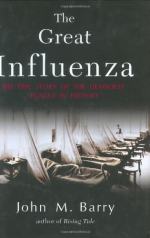|
This section contains 439 words (approx. 2 pages at 400 words per page) |

|
The Great Influenza Summary & Study Guide Description
The Great Influenza Summary & Study Guide includes comprehensive information and analysis to help you understand the book. This study guide contains the following sections:
This detailed literature summary also contains Topics for Discussion on The Great Influenza by John M. Barry.
The following version of the book was used to create this study guide: Barry, John M. The Great Influenza. Penguin Books, Oct. 4, 2005. Kindle.
In the non-fiction book, The Great Influenza by John M. Barry, the author describes the 1918 influenza pandemic, a medical tragedy believed to have killed as many as 100 million people worldwide. Barry begins his story by describing the subpar medical training and providers in America leading up to this pandemic. He moves forward to describe how the war helped to spread the flu not only from soldiers to American citizens, but also spread it throughout the world. Meanwhile, politics and the war effort kept the country from focusing on helping the people suffering from the disease.
Barry first focuses on the people whom he calls warriors in the medical field. These people include William Henry Welch, a doctor and scientist, who traveled to Europe to learn about medicine there. Welch brought knowledge of science and pathology back to the United States with him where he was instrumental in the opening of the Johns Hopkins University and Hospital. Another warrior Barry identifies is Paul Lewis, a scientist enlisted by the military to help find a cure or vaccine for the flu.
Barry next describes the outbreak of the flu in Haskell County, Kansas, the place where it is believed the strain of flu that caused the 1918 epidemic originated. He goes on the explain the special features of the flu virus that allow it to hide from the immune system while it replicates. Barry notes the ability of the flu virus to mutate rapidly so the body has trouble identifying it and fighting it off.
Barry describes the bad decisions made in the military and civilian America that made conditions ripe for an epidemic. The flu seemed to strike otherwise healthy people and kill them within just a few days, the result of an overworked immune system. Victims struggled to breathe, bled from their eyes, nose, and mouth, and often turned cyanotic as their lungs were unable to supply the heart with enough oxygen.
Meanwhile, scientists like Lewis were working to find a cure or vaccine for the flu. However, they were working on the incorrect assumption that the flu was caused by bacteria. Politicians refused to cooperate with the scientists and doctors when they asked that the people be quarantined so the disease spread unchecked. Despite the work done by scientists, they never came up with a way to cure the flu. The virus burned itself out by working its way through all of the available victims. Those who survived developed some immunity after they recovered.
Read more from the Study Guide
|
This section contains 439 words (approx. 2 pages at 400 words per page) |

|



